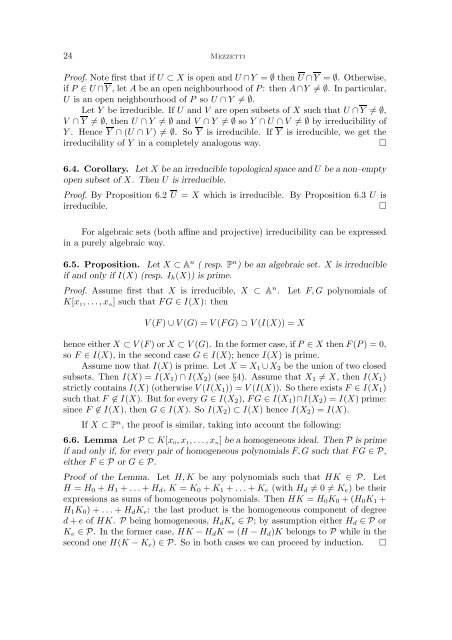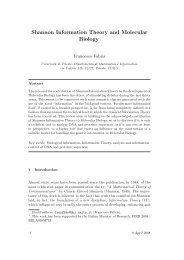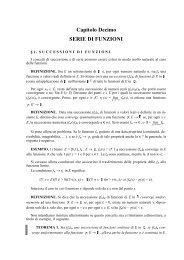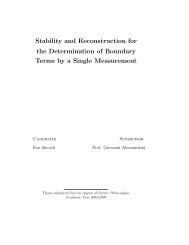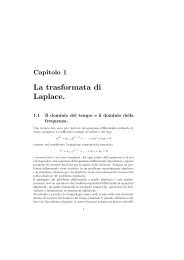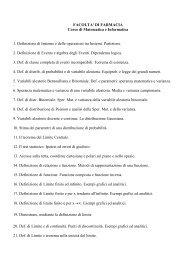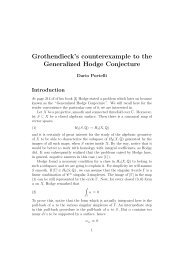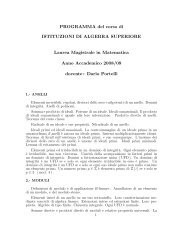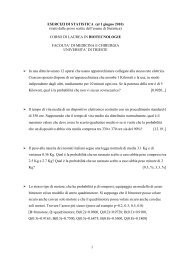INTRODUCTION TO ALGEBRAIC GEOMETRY Note del corso di ...
INTRODUCTION TO ALGEBRAIC GEOMETRY Note del corso di ...
INTRODUCTION TO ALGEBRAIC GEOMETRY Note del corso di ...
You also want an ePaper? Increase the reach of your titles
YUMPU automatically turns print PDFs into web optimized ePapers that Google loves.
24 MezzettiProof. <strong>Note</strong> first that if U ⊂ X is open and U ∩Y = ∅ then U ∩Y = ∅. Otherwise,if P ∈ U ∩Y , let A be an open neighbourhood of P: then A∩Y ≠ ∅. In particular,U is an open neighbourhood of P so U ∩ Y ≠ ∅.Let Y be irreducible. If U and V are open subsets of X such that U ∩Y ≠ ∅,V ∩ Y ≠ ∅, then U ∩ Y ≠ ∅ and V ∩ Y ≠ ∅ so Y ∩ U ∩ V ≠ ∅ by irreducibility ofY . Hence Y ∩ (U ∩ V ) ≠ ∅. So Y is irreducible. If Y is irreducible, we get theirreducibility of Y in a completely analogous way.□6.4. Corollary. Let X be an irreducible topological space and U be a non–emptyopen subset of X. Then U is irreducible.Proof. By Proposition 6.2 U = X which is irreducible. By Proposition 6.3 U isirreducible.□For algebraic sets (both affine and projective) irreducibility can be expresse<strong>di</strong>n a purely algebraic way.6.5. Proposition. Let X ⊂ A n ( resp. P n ) be an algebraic set. X is irreducibleif and only if I(X) (resp. I h (X)) is prime.Proof. Assume first that X is irreducible, X ⊂ A n . Let F, G polynomials ofK[x 1 , . . ., x n ] such that FG ∈ I(X): thenV (F) ∪ V (G) = V (FG) ⊃ V (I(X)) = Xhence either X ⊂ V (F) or X ⊂ V (G). In the former case, if P ∈ X then F(P) = 0,so F ∈ I(X), in the second case G ∈ I(X); hence I(X) is prime.Assume now that I(X) is prime. Let X = X 1 ∪X 2 be the union of two closedsubsets. Then I(X) = I(X 1 ) ∩ I(X 2 ) (see §4). Assume that X 1 ≠ X, then I(X 1 )strictly contains I(X) (otherwise V (I(X 1 )) = V (I(X)). So there exists F ∈ I(X 1 )such that F ∉ I(X). But for every G ∈ I(X 2 ), FG ∈ I(X 1 )∩I(X 2 ) = I(X) prime:since F ∉ I(X), then G ∈ I(X). So I(X 2 ) ⊂ I(X) hence I(X 2 ) = I(X).If X ⊂ P n , the proof is similar, taking into account the following:6.6. Lemma Let P ⊂ K[x 0 , x 1 , . . ., x n ] be a homogeneous ideal. Then P is primeif and only if, for every pair of homogeneous polynomials F, G such that FG ∈ P,either F ∈ P or G ∈ P.Proof of the Lemma. Let H, K be any polynomials such that HK ∈ P. LetH = H 0 + H 1 + . . . + H d , K = K 0 + K 1 + . . . + K e (with H d ≠ 0 ≠ K e ) be theirexpressions as sums of homogeneous polynomials. Then HK = H 0 K 0 + (H 0 K 1 +H 1 K 0 ) + . . . + H d K e : the last product is the homogeneous component of degreed + e of HK. P being homogeneous, H d K e ∈ P; by assumption either H d ∈ P orK e ∈ P. In the former case, HK − H d K = (H − H d )K belongs to P while in thesecond one H(K − K e ) ∈ P. So in both cases we can proceed by induction. □


